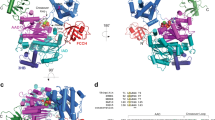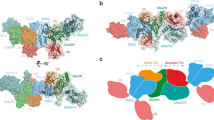Abstract
Ubiquitin (denoted Ub) receptor proteins as a group must contain a diverse set of binding specificities to distinguish the many forms of polyubiquitin (polyUb) signals. Previous studies suggested that the large class of ubiquitin-associated (UBA) domains contains members with intrinsic specificity for Lys63-linked polyUb or Lys48-linked polyUb, thus explaining how UBA-containing proteins can mediate diverse signaling events. Here we show that previously observed Lys63-polyUb selectivity in UBA domains is the result of an artifact in which the dimeric fusion partner, glutathione S-transferase (GST), positions two UBAs for higher affinity, avid interactions with Lys63-polyUb, but not with Lys48-polyUb. Freed from GST, these UBAs are either nonselective or prefer Lys48-polyUb. Accordingly, NMR experiments reveal no Lys63-polyUb–specific binding epitopes for these UBAs. We reexamine previous conclusions based on GST-UBAs and present an alternative model for how UBAs achieve a diverse range of linkage specificities.
This is a preview of subscription content, access via your institution
Access options
Subscribe to this journal
Receive 12 print issues and online access
$189.00 per year
only $15.75 per issue
Buy this article
- Purchase on Springer Link
- Instant access to full article PDF
Prices may be subject to local taxes which are calculated during checkout






Similar content being viewed by others
References
Pickart, C.M. & Eddins, M.J. Ubiquitin: structures, functions, mechanisms. Biochim. Biophys. Acta 1695, 55–72 (2004).
Peng, J. et al. A proteomics approach to understanding protein ubiquitination. Nat. Biotechnol. 21, 921–926 (2003).
Pickart, C.M. & Fushman, D. Polyubiquitin chains: polymeric protein signals. Curr. Opin. Chem. Biol. 8, 610–616 (2004).
Sun, L. & Chen, Z.J. The novel functions of ubiquitination in signaling. Curr. Opin. Cell Biol. 16, 119–126 (2004).
Chen, Z.J. & Sun, L.J. Nonproteolytic functions of ubiquitin in cell signaling. Mol. Cell 33, 275–286 (2009).
Hicke, L. & Dunn, R. Regulation of membrane protein transport by ubiquitin and ubiquitin-binding proteins. Annu. Rev. Cell Dev. Biol. 19, 141–172 (2003).
Shilatifard, A. Chromatin modifications by methylation and ubiquitination: implications in the regulation of gene expression. Annu. Rev. Biochem. 75, 243–269 (2006).
Raasi, S., Varadan, R., Fushman, D. & Pickart, C.M. Diverse polyubiquitin interaction properties of ubiquitin-associated domains. Nat. Struct. Mol. Biol. 12, 708–714 (2005).
Raasi, S. & Pickart, C.M. Rad23 ubiquitin-associated domains (UBA) inhibit 26 S proteasome-catalyzed proteolysis by sequestering lysine 48-linked polyubiquitin chains. J. Biol. Chem. 278, 8951–8959 (2003).
Raasi, S., Orlov, I., Fleming, K.G. & Pickart, C.M. Binding of polyubiquitin chains to ubiquitin-associated (UBA) domains of HHR23A. J. Mol. Biol. 341, 1367–1379 (2004).
Trempe, J.F. et al. Mechanism of Lys48-linked polyubiquitin chain recognition by the Mud1 UBA domain. EMBO J. 24, 3178–3189 (2005).
Swanson, K.A., Hicke, L. & Radhakrishnan, I. Structural basis for monoubiquitin recognition by the Ede1 UBA domain. J. Mol. Biol. 358, 713–724 (2006).
Varadan, R., Assfalg, M., Raasi, S., Pickart, C. & Fushman, D. Structural determinants for selective recognition of a Lys48-linked polyubiquitin chain by a UBA domain. Mol. Cell 18, 687–698 (2005).
Haririnia, A., D'Onofrio, M. & Fushman, D. Mapping the interactions between Lys48 and Lys63-linked di-ubiquitins and a ubiquitin-interacting motif of S5a. J. Mol. Biol. 368, 753–766 (2007).
Scheibner, K.A., Zhang, Z. & Cole, P.A. Merging fluorescence resonance energy transfer and expressed protein ligation to analyze protein-protein interactions. Anal. Biochem. 317, 226–232 (2003).
Zhang, D., Raasi, S. & Fushman, D. Affinity makes the difference: nonselective interaction of the UBA domain of Ubiquilin-1 with monomeric ubiquitin and polyubiquitin chains. J. Mol. Biol. 377, 162–180 (2008).
Sims, J.J. & Cohen, R.E. Linkage-specific avidity defines the lysine 63-linked polyubiquitin-binding preference of rap80. Mol. Cell 33, 775–783 (2009).
Varadan, R., Walker, O., Pickart, C. & Fushman, D. Structural properties of polyubiquitin chains in solution. J. Mol. Biol. 324, 637–647 (2002).
Kaplan, W. et al. Conformational stability of pGEX-expressed Schistosoma japonicum glutathione S-transferase: a detoxification enzyme and fusion-protein affinity tag. Protein Sci. 6, 399–406 (1997).
Mueller, T.D. & Feigon, J. Solution structures of UBA domains reveal a conserved hydrophobic surface for protein-protein interactions. J. Mol. Biol. 319, 1243–1255 (2002).
Bayrer, J.R., Zhang, W. & Weiss, M.A. Dimerization of doublesex is mediated by a cryptic ubiquitin-associated domain fold: implications for sex-specific gene regulation. J. Biol. Chem. 280, 32989–32996 (2005).
Kozlov, G. et al. Structural basis for UBA-mediated dimerization of c-Cbl ubiquitin ligase. J. Biol. Chem. 282, 27547–27555 (2007).
Prag, G. et al. Mechanism of ubiquitin recognition by the CUE domain of Vps9p. Cell 113, 609–620 (2003).
Peschard, P. et al. Structural basis for ubiquitin-mediated dimerization and activation of the ubiquitin protein ligase Cbl-b. Mol. Cell 27, 474–485 (2007).
Lowe, E.D. et al. Structures of the Dsk2 UBL and UBA domains and their complex. Acta Crystallogr. D Biol. Crystallogr. 62, 177–188 (2006).
Sasaki, T., Funakoshi, M., Endicott, J.A. & Kobayashi, H. Budding yeast Dsk2 protein forms a homodimer via its C-terminal UBA domain. Biochem. Biophys. Res. Commun. 336, 530–535 (2005).
Matiuhin, Y. et al. Extraproteasomal Rpn10 restricts access of the polyubiquitin-binding protein Dsk2 to proteasome. Mol. Cell 32, 415–425 (2008).
Varadan, R. et al. Solution conformation of Lys63-linked di-ubiquitin chain provides clues to functional diversity of polyubiquitin signaling. J. Biol. Chem. 279, 7055–7063 (2004).
Ryabov, Y. & Fushman, D. Interdomain mobility in di-ubiquitin revealed by NMR. Proteins 63, 787–796 (2006).
Kim, I. & Rao, H. What's Ub chain linkage got to do with it? Sci. STKE 2006, pe18 (2006).
Friedlander, R., Jarosch, E., Urban, J., Volkwein, C. & Sommer, T. A regulatory link between ER-associated protein degradation and the unfolded-protein response. Nat. Cell Biol. 2, 379–384 (2000).
Chen, Z. & Pickart, C.M. A 25-kilodalton ubiquitin carrier protein (E2) catalyzes multi-ubiquitin chain synthesis via lysine 48 of ubiquitin. J. Biol. Chem. 265, 21835–21842 (1990).
Xu, P. et al. Quantitative proteomics reveals the function of unconventional ubiquitin chains in proteasomal degradation. Cell 137, 133–145 (2009).
Lo, Y.C. et al. Structural basis for recognition of diubiquitins by NEMO. Mol. Cell 33, 602–615 (2009).
Broemer, M. & Meier, P. Ubiquitin-mediated regulation of apoptosis. Trends Cell Biol. 19, 130–140 (2009).
Gyrd-Hansen, M. et al. IAPs contain an evolutionarily conserved ubiquitin-binding domain that regulates NF-κB as well as cell survival and oncogenesis. Nat. Cell Biol. 10, 1309–1317 (2008).
Seibenhener, M.L., Geetha, T. & Wooten, M.W. Sequestosome 1/p62–more than just a scaffold. FEBS Lett. 581, 175–179 (2007).
Bjørkøy, G., Lamark, T. & Johansen, T. p62/SQSTM1: a missing link between protein aggregates and the autophagy machinery. Autophagy 2, 138–139 (2006).
Tan, J.M., Wong, E.S., Dawson, V.L., Dawson, T.M. & Lim, K.L. Lysine 63-linked polyubiquitin potentially partners with p62 to promote the clearance of protein inclusions by autophagy. Autophagy 4, 251–253 (2007).
Seibenhener, M.L. et al. Sequestosome 1/p62 is a polyubiquitin chain binding protein involved in ubiquitin proteasome degradation. Mol. Cell. Biol. 24, 8055–8068 (2004).
Bjørkøy, G. et al. p62/SQSTM1 forms protein aggregates degraded by autophagy and has a protective effect on huntingtin-induced cell death. J. Cell Biol. 171, 603–614 (2005).
Tan, J.M. et al. Lysine 63-linked ubiquitination promotes the formation and autophagic clearance of protein inclusions associated with neurodegenerative diseases. Hum. Mol. Genet. 17, 431–439 (2008).
Olzmann, J.A. & Chin, L.S. Parkin-mediated K63-linked polyubiquitination: a signal for targeting misfolded proteins to the aggresome-autophagy pathway. Autophagy 4, 85–87 (2008).
Kirkin, V. et al. A role for NBR1 in autophagosomal degradation of ubiquitinated substrates. Mol. Cell 33, 505–516 (2009).
Aguilar, R.C., Watson, H.A. & Wendland, B. The yeast Epsin Ent1 is recruited to membranes through multiple independent interactions. J. Biol. Chem. 278, 10737–10743 (2003).
Gagny, B. et al. A novel EH domain protein of Saccharomyces cerevisiae, Ede1p, involved in endocytosis. J. Cell Sci. 113, 3309–3319 (2000).
Maldonado-Báez, L. et al. Interaction between Epsin/Yap180 adaptors and the scaffolds Ede1/Pan1 is required for endocytosis. Mol. Biol. Cell 19, 2936–2948 (2008).
Wilkinson, K.D. Quantitative analysis of protein-protein interactions. Methods Mol. Biol. 261, 15–32 (2004).
Keller, R. The Computer Aided Resonance Assignment Tutorial (CANTINA, Goldau, Switzerland, 2004).
Pickart, C.M. & Raasi, S. Controlled synthesis of polyubiquitin chains. Methods Enzymol. 399, 21–36 (2005).
Acknowledgements
We thank P. Cole (Johns Hopkins School of Medicine) for materials and advice for fluorescent labeling by expressed protein ligation. Work in this study was supported in part by the US National Istitutes of Health (NIH) grant GM065334 (to D.F.) and NIH Roadmap grant RR020839.
Author information
Authors and Affiliations
Contributions
J.J.S. and R.E.C. conceived of the study; J.J.S., D.F. and R.E.C. designed the experiments; J.J.S., R.E.C., A.H. and B.C.D. prepared the proteins; J.J.S. performed all the cloning and binding assays, and interpreted the data with R.E.C.; A.H. and B.C.D. performed the NMR experiments and analyzed the data with D.F.; J.J.S., D.F. and R.E.C. wrote the paper.
Corresponding author
Supplementary information
Supplementary Text and Figures
Supplementary Figures 1–3, Supplementary Table 1 and Supplementary Methods (PDF 579 kb)
Rights and permissions
About this article
Cite this article
Sims, J., Haririnia, A., Dickinson, B. et al. Avid interactions underlie the Lys63-linked polyubiquitin binding specificities observed for UBA domains. Nat Struct Mol Biol 16, 883–889 (2009). https://doi.org/10.1038/nsmb.1637
Received:
Accepted:
Published:
Issue Date:
DOI: https://doi.org/10.1038/nsmb.1637
This article is cited by
-
The Habc domain of syntaxin 3 is a ubiquitin binding domain
Scientific Reports (2020)
-
Structural insights into two distinct binding modules for Lys63-linked polyubiquitin chains in RNF168
Nature Communications (2018)
-
Isolation of ubiquitinated substrates by tandem affinity purification of E3 ligase–polyubiquitin-binding domain fusions (ligase traps)
Nature Protocols (2016)
-
APC/C-mediated multiple monoubiquitylation provides an alternative degradation signal for cyclin B1
Nature Cell Biology (2012)
-
Polyubiquitin-sensor proteins reveal localization and linkage-type dependence of cellular ubiquitin signaling
Nature Methods (2012)



